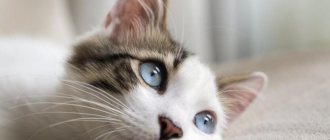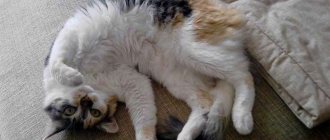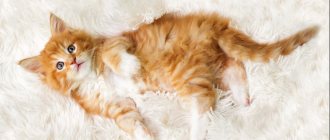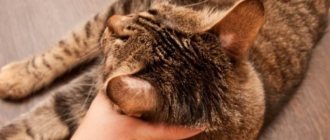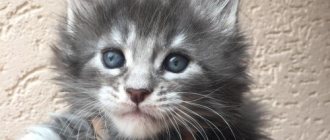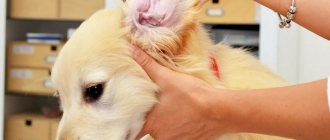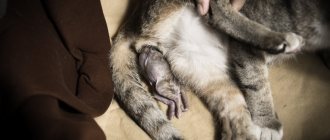6374Pavel
Changes in metabolic processes occurring in the body of animals are often associated with the sebaceous glands. Black spots on a cat's chin do not cause any discomfort and may even go away unnoticed on their own. But it happens that these processes go to another stage and spread to the inner thigh, fingers, and groin area, which cannot be ignored.
This article will tell you about the reasons for the appearance of acne under the fur on the skin of a cat, treatment methods and preventive actions for this skin disease.
© shutterstock
What is acne?
Acne in cats is not a very common disease. Therefore, the appearance of acne in the area of the chin, abdomen, mouth, ears and base of the tail causes some surprise in a person.
This dermatological pathology is associated with improper functioning of the sebaceous glands - as a result, pores are clogged and a serious disturbance in metabolic processes occurs.
The pores are closed by old epithelium, which is glued to new cells by fatty secretions. This causes black or white pimples to form. The type of rash depends on where the blockage occurs and the sebaceous plug appears - inside or outside the pore. If the process is not accompanied by infection, the skin problem may disappear on its own.
Causes of acne
The appearance of skin pathologies accompanies animals of different ages and breeds. Anomalies in the functioning of the sebaceous glands most often affect furry cats with weakened immune systems and poor living conditions. In advanced cases, the animal experiences great discomfort, which later develops into infectious diseases and dermatitis. It has been established that the appearance of acne in cats has different causes; they can be conditionally divided into two large groups - external and internal.
External factors
Veterinarians cannot absolutely accurately name the problems that lead to dermatological pathologies. One of the most common external factors in the appearance of acne is considered to be improper or insufficient care of the owner for his pet.
Acne on a cat's chin occurs because it is difficult for her to lick this part herself. As a result, sebaceous plugs oxidize and clog skin pores. Other causes of acne in cats are:
- improper diet;
- taking certain medications;
- experienced stressful conditions;
- poor place of detention - too humid, stuffy, etc.;
- dirty place for the cat to feed and rest.
Interestingly, skin diseases also appear as a reaction to surrounding objects. For example, a negative reaction is caused by low-quality plastic, from which bowls for eating and drinking are made. Daily contact with such material leads to the appearance of black spots on the chin of a pet.
At-risk groups
Some experts claim that the causes of acne in cats are not related to the gender, age or breed of the mustachioed friend, while others talk about certain patterns. For example, animals after undergoing sterilization and castration are least susceptible to blockage of the sebaceous glands.
Long-haired individuals are more likely to suffer from acne, which appears in the folds and on the face. In animals with short hair, inflammation occurs mainly on the chin. Black dots are most visible in bald individuals who have increased sebum secretion.
Causes of rashes depending on location
Your cat has worms: how to treat them at home
According to experts, one of the most common causes of blackheads in cats is pollution. But at the same time, this condition can be a consequence of other reasons.
Black spots on the lower jaw
Dark-colored sores can appear on the lower jaw in cats due to hereditary predisposition. In this case, you can ensure the normal condition of the skin with the help of properly selected hygiene products.
Black dots on a cat's lower jaw
On the lips
Having noticed black spots on a cat's lips, every owner should be wary. This manifestation may indicate the development of fungal diseases. At the first signs, it is important to immediately seek qualified help, since it is impossible to independently determine the type of infection.
Acne on a cat's lips
In the mouth
Sometimes attentive and caring owners may discover that black spots have appeared in the cat’s mouth. Basically, such a deviation indicates natural processes that do not pose a threat to the health and life of the pet. But still, in rare cases, this may indicate the development of pathology.
Important! Black spots in the mouth can appear as a result of normal pigmentation, allergic reactions, stress, dirty dishes, poor environmental conditions, and oncology.
Symptoms, distinctive features, stages
Sometimes black spots on a pet's skin form and disappear without the owner noticing. This is explained by the fact that the mustachioer does not experience any discomfort and does not scratch the problematic part of the body. Acne goes away on its own thanks to a strong immune system.
However, repeated inflammation causes significant suffering for the furry ones. An attentive owner will notice the changes that occur on the animal’s body.
In addition, the behavior of the mustache also changes. He is constantly irritated, becomes restless, begins to refuse food, and is constantly itching. External symptoms may go through the following stages:
- Initially, redness of the skin appears.
- There are more pimples, and in appearance they look like dirt on the fur.
- The affected part of the body begins to swell and increase in size.
- Gradually, ulcers and inflammation of the follicles appear.
- Crusts of pus and blood form on scratched areas.
- The last stage is the loss of fur in the affected areas.
It is important to notice dermatological problems with your pet’s skin at the initial stage. If the owner takes action in time, the patient will get rid of the pathology much faster. Relapse is caused by incorrect or delayed treatment.
On what parts of the body do blackheads usually appear?
Sebaceous glands are located throughout the pet's body. Owners online show cat acne in photos, and there it is most often localized in the area of the lips and chin.
If the pathology remains unnoticed, then acne can subsequently spread to other parts of the cat’s body. Particularly affected are areas that are constantly exposed to dirt or cannot be thoroughly cleaned. For example, the area around the tail, armpits, nose and bridge of the nose.
How to prevent the development of the disease
Preventing acne in your pet is:
- careful attention to the health of the cat;
- compliance with hygiene measures, especially in acne-prone breeds: bathe in a timely manner;
- wipe your face after eating;
- feed/water only from clean dishes;
- do not use plastic bowls;
Carrying out diagnostics
It is impossible to find out for yourself what kind of black marks appeared on the body of a pet. Even with some experience and knowledge, the patient’s owner will not be able to make an accurate diagnosis. To determine the nature of the skin rash, you must consult a veterinarian.
The doctor will examine the patient and find out details about the animal’s nutrition. Information about the last vaccination and deworming performed will be important for making a diagnosis. For an accurate clinical picture, diagnostic procedures can be performed:
- Scraping from the diseased area to determine the pathogenic microorganism.
- Blood sampling for serological analysis aimed at excluding other similar diseases.
- Bacteriological culture to determine the type of pathogen.
- A biopsy prescribed to identify benign or malignant neoplasms.
As a result, the veterinarian will have all the data to make an accurate diagnosis and develop a treatment regimen. The therapy prescribed by the doctor will be aimed at symptomatic elimination of skin manifestations and relief of negative consequences.
How to cure cat acne
Acne in cats can be treated at home. If you strictly follow the prescriptions and recommendations of the veterinarian, you will be able to help your sick pet quickly enough.
The choice of medications is explained by the age, characteristics of the patient’s body, as well as the complexity of the clinical picture of the disease. If a repeated manifestation of skin pathology is recorded, then the prescribed drugs are much more aggressive. It is important for the owner to follow the recommendations on the dosage and duration of medication use.
Ointments, shampoos and folk remedies
The veterinarian prescribes local or complex therapy. When diagnosing acne in cats, the doctor determines how to treat the patient. Therapy depends on the frequency of skin rashes and the severity of the disease. The main recommendation from a specialist is not to squeeze out mature acne and not to self-medicate. The following can be used as effective medicines:
- Percutan ointment
, applied twice a day until the problem disappears completely. Furacilin, which is the main component of the drug, dyes the hair yellow; there is no need to be afraid of this.
- Mupirocin ointment
(Bactroban), used to treat damaged areas during re-infection, formation of purulent and bloody crusts.
- Prednisolone ointment
is prescribed in case of severe inflammation, as it contains powerful substances - corticosteroids. They have a strong anti-inflammatory and healing effect.
Doctors do not recommend frequent use of antiseptic compounds: chlorhexidine, hydrogen peroxide, miramistin, boric or salicylic alcohol, iodine. Their constant application leads to dry skin. Instead, they are treated with shampoos and soaps with antiseborrheic properties. For example, tar soap has proven itself well.
As additional measures, you can use folk remedies. To get rid of blackheads and inflammation, prepare an infusion of chamomile and calendula, in which two furatsilin tablets are dissolved. Apply the liquid to the affected parts twice a day. Pieces of fresh pumpkin, which are used to wipe acne three times a day, help well.
Diet
You can speed up the treatment of cat acne with the right diet. The veterinarian immediately prescribes a diet of low-fat foods. During therapy, as in ordinary life, it is impossible to feed the patient food from the master’s table. Such food contains a large amount of preservatives and flavor enhancers that are harmful to pets.
The patient's diet should consist of foods that do not cause allergies: lean meat, offal, cereals. As auxiliary elements, the pet is given vitamin and mineral supplements, Omega-3 and Omega-6 acids.
If the cat eats commercial food, the doctor will recommend a low-fat dietary product in the form of granules or pates.
Hygiene procedures
Getting rid of acne in cats using home treatment without veterinarian advice is difficult. Only in combination with hygienic procedures and proper conditions for keeping the patient is a guaranteed cure possible.
Acne in cats on the chin without treatment leads to the formation of large ulcers. Without proper hygiene, pathogenic microorganisms will penetrate inside and lead to complications. What actions should be taken to maintain hygiene:
- Treat affected parts of the body with medicinal ointments prescribed by a veterinarian.
- Before using the preparations, disinfect the skin with a 3% solution of hydrogen peroxide - if there are wounds.
- For long-haired pets, it is necessary to trim or shave the hair on the affected area during treatment.
- If the points are located on the face (for example, on the chin), after eating you need to wipe your pet’s mouth to remove food debris.
It is important to pay attention to what your pet comes into contact with. It is advisable to replace plastic bowls for water and food with iron, ceramic or glass. If your furry dog wears a collar, it must be removed during treatment. This will avoid rubbing the affected areas and re-infection.
Do I need to contact a veterinarian?
Only a veterinarian can determine the nature of the appearance of skin rashes on the body of an animal. Examination of the patient and conducting additional studies are of great importance for making the correct diagnosis.
Skin scrapings and analysis for the presence of fungal or parasitic diseases will help to exclude diseases with similar symptoms: scabies, granuloma, allergies, demodicosis, dermatophytosis.
Treatment of a pet for an ailment
After examination, a qualified specialist prescribes comprehensive treatment, which is carried out at home or in a veterinary clinic. It includes:
- Local processing. Tar soap, specialized shampoo, antiseptic solutions, and a bandage soaked in calendula tincture are used.
- Taking prescribed medications. Prescribed in more advanced cases, in the presence of the development of a secondary infection. A monthly intake of an individually selected vitamin complex is recommended.
- Injections. If necessary, medications are selected by the attending physician.
- Adjustment of the usual diet. During treatment and recovery, the pet is transferred to a low-fat diet.
You may be interested in: Cleaning the anal glands at home: what you need to know
The dangers of cat acne
Pathologies caused by blockage and further inflammation of the sebaceous glands are not always considered by owners to be serious problems. However, acne should not be left unattended.
For the animal itself
The pet experiences great discomfort from the accumulation of black spots on the chin, around the nose, mouth, and at the base of the tail. The cat scratches the affected areas of the body and brings dirt into the wounds. As a result, purulent ulcers and crusts of blood are formed. Pathogenic microorganisms can penetrate through them, causing dangerous infections that are long and difficult to treat.
For man
The skin pathology, which is unpleasant for the pet fluffy, is not contagious to the owner and his family members. Only infections that accompany an advanced form of illness (for example, lichen) can be dangerous to humans. Therefore, it is impossible not to treat and allow further spread of acne throughout the animal’s body.
Causes of fungus
It is believed that strange bald patches on the chin may be a sign of ringworm (ringworm). This is a common group of fungal skin diseases that practicing veterinarians encounter very often.
Most pathogens of mycoses (for example, the Trichophyton fungus) have very high virulence, causing disease even in animals with a relatively normal immune system. Moreover, lichens are extremely dangerous because they are not species specific.
Remember! When interacting with a sick cat, both you and your family members risk getting sick. Other pets, including dogs, hamsters and other animals, can easily become infected.
But! Note that, regardless of the cause (i.e., the specific type of pathogen), the development of the disease is greatly facilitated by poor feeding, stress and allergies. These factors adversely affect the state of the animal's immune system.
Ringworm causes hair loss (hairs break off near the root), erythema and baldness. One of the distinguishing signs of many types of lichen is the appearance of round bald areas on the skin, in the center of which there is a red spot. Such lesions strongly resemble cigarette burns in their appearance.
Despite the presence of relatively specific symptoms, diagnosing dermatomycosis can be very difficult, sometimes dragging on for several weeks (the pathogen grows very slowly on nutrient media). The sooner the owner notices that something is wrong with his pet, the greater the chance of quickly treating the cat and avoiding infection himself.
Prevention of acne in cats
The task of any owner is to provide proper care for his mustachioed friend. Thus, water and food bowls should be washed once a day and new food should not be added to a plate with old food.
Drinking water should always be fresh. If your pet has a tendency to form black spots, then after each meal you need to wipe its face.
Blackheads in cats usually affect the chin and areas around the mouth. Most owners do not attach importance to this skin disease, hoping for their pet to heal on its own. But lack of attention to this pathology can lead to serious problems. In order not to aggravate the situation, the owner must know the causes and methods of treating blackheads.
The article is for informational purposes only. Contact your veterinarian!
Preventive measures
The set of preventive measures includes several requirements available to everyone. It is unacceptable to use plastic dishes to feed the animal. Many pets are sensitive to chemicals, which can cause allergies and, as a result, acne. Over time, scratches form on the plastic, where food debris gets trapped, creating a favorable environment for the proliferation of pathogens.
Bacterial infection on the chin.
It is necessary to keep the animal's dishes clean. Otherwise, there is a risk of infection . Your cat's water should be changed at least once or twice a day. Water must be clean, fresh, filtered.
Chin area
Since the chin area is inaccessible to the cat for licking, it should be wiped after each feeding.
If a cat has had ACNE, then blackheads may appear again due to the risk of relapse. In such cases, it is recommended to treat the wool with antiseptic solutions.
Animals that have experienced a single case of acne are prone to its repetition and relapses, so the risk area should be treated with antiseptic solutions after eating.
Do not allow the cat's body to weaken. A balanced diet containing nutrients rich in vitamins, microelements, omega-3, omega-6 fatty acids.
General recommendations
Limit the consumption of fatty foods in cats prone to illness. Monitor the animal’s condition, mood swings, and signs of nervousness.
This is interesting: Symptoms and treatment of distemper in cats using folk remedies
